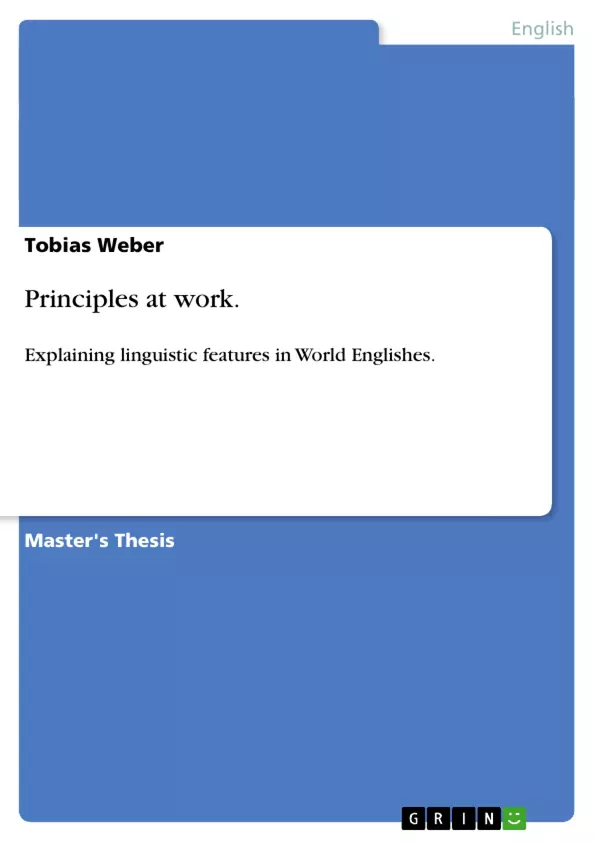This paper deals with different explanatory models for the emergence or existence of linguistic features in varieties of the English language. After a brief overview of the current research, five non-standard varieties from all over the world, ranging from a traditional dialect to pidgins and creoles, are analyzed in two morphosyntactic and two phonological features. The theoretical approaches are discussed with reference to the features, providing recommendations for or advise against certain explanatory models. Finally, Bybee's usage-based functionalist approach and the usage-based synthesis of new-dialect formation according to Ansaldo are highlighted as plausible explanations for the features. Formalist, descriptive universals are rejected in favour of functionalist, cognitive universals in human language processing, acquisition and evolution, as they occur in language contact or speaker contact scenarios – the driving force of language change.
Inhaltsverzeichnis (Table of Contents)
- 1. Introduction
- 1.1 Aim of this paper
- 1.2 Methods
- 1.3 Basic assumptions
- 2. Current research
- 2.1 Sociolinguistic approaches
- 2.1.1 Schreier – linguistic endemicity
- 2.1.2 Andersen – center and periphery
- 2.1.3 Trudgill – new-dialect formation
- 2.2 Language evolution
- 2.2.1 Mufwene – language as an organism
- 2.2.2 Croft – Theory of Utterance Selection
- 2.3 Linguistic formalism
- 2.3.1 Chomsky – Universal Grammar
- 2.3.2 Bickerton – Language Bioprogram Hypothesis
- 2.3.3 Chambers – vernacular universals
- 2.4 Synthetic approaches
- 2.4.1 Tomasello – usage-based approach
- 2.4.2 Ansaldo – Adaption Theory
- 2.4.3 Bybee – usage-based functionalism
- 2.5 Summary
- 3. Selection of varieties of English
- 3.1 Traditional L1: Scottish English
- 3.2 High-contact L1: New Zealand English
- 3.3 Indigenized L2: Chicano English
- 3.4 Creole: Bonin Island English/Ogasawara Mixed Language
- 3.5 Pidgin: Norfolk Island/Pitcairn English
- 4. Selection of linguistic features
- 4.1 Morphosyntactic features
- 4.1.1 F34: alternative forms for 2nd person plural pronouns
- 4.1.2 F154: multiple negation
- 4.2 Phonological features
- 4.2.1 Monophthongization
- 4.2.2 Th-movement
- 5. Discussion
- 5.1 Sociolinguistic approaches
- 5.1.1 Theoretical outline
- 5.1.2 Matching the data
- 5.2 Language evolution
- 5.2.1 Theoretical outline
- 5.2.2 Matching the data
- 5.3 Linguistic formalism
- 5.3.1 Theoretical outline
- 5.3.2 Matching the data
- 5.4 Synthetic approaches
- 5.4.1 Theoretical outline
- 5.4.2 Matching the data
- 5.5 Conclusion – principles at work
- 6. Considerations
- 6.1 Does the input matter? Languages vs. dialects in contact
- 6.2 A different perspective on universals
- 6.3 Reflection upon material and methods
- 6.4 Outlook
Zielsetzung und Themenschwerpunkte (Objectives and Key Themes)
This thesis examines the emergence and existence of linguistic features in non-standard varieties of English by comparing five varieties from around the world, each representing a different category of non-standard English. The main objective is to analyze the selected varieties in terms of two morphosyntactic and two phonological features, and to assess the applicability of different theoretical models for explaining their emergence and persistence. Key themes include: * **Language contact and change**: The thesis examines how contact between different varieties of English and other languages influences the development of new features. * **Substrate influence**: The study investigates the role of substrate languages in shaping the phonological and grammatical features of non-standard varieties. * **Sociolinguistic factors**: The research considers the impact of social factors, such as prestige, social class, and age, on the adoption and spread of linguistic features. * **Cognitive and functional principles**: The thesis explores the role of cognitive and functional principles, such as motor economy, cognitive overload, and communicative function, in explaining language change. * **Universal grammar vs. usage-based functionalism**: The study assesses the merits of competing theoretical models for explaining language universals and contact-induced language change.Zusammenfassung der Kapitel (Chapter Summaries)
Chapter 1 introduces the research topic, outlines the aims of the study, and discusses the methods used. It also lays out basic assumptions and definitions of key terms, such as pidgin, creole, and contact language formation. Chapter 2 reviews relevant research on linguistic change, examining various approaches from sociolinguistics, language evolution, linguistic formalism, and synthetic models. This chapter provides a comprehensive overview of the theoretical landscape for explaining language change in contact situations. Chapter 3 presents the five selected varieties of English, focusing on their linguistic ecology, historical background, and social contexts. This chapter offers a detailed description of each variety, including their geographical location, sociolinguistic characteristics, and historical influences. Chapter 4 introduces the four linguistic features that will be analyzed in the study: alternative forms for 2nd person plural pronouns (F34), multiple negation (F154), monophthongization, and th-movement. This chapter provides examples of each feature as they occur in the selected varieties of English. Chapter 5 discusses the theoretical approaches presented in Chapter 2 and matches them to the data collected in Chapters 3 and 4. The chapter aims to identify the most plausible explanations for the observed features in each variety of English, providing recommendations for or against certain explanatory models.Schlüsselwörter (Keywords)
This paper focuses on the key concepts of contact linguistics, language change, World Englishes, non-standard varieties, sociolinguistics, language evolution, universal grammar, usage-based functionalism, substrate influence, and the founder principle. The analysis explores the interplay of these concepts in explaining the emergence and persistence of linguistic features in non-standard varieties of English.- Quote paper
- B.Ed. Tobias Weber (Author), 2013, Principles at work., Munich, GRIN Verlag, https://www.grin.com/document/264081



